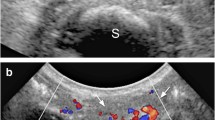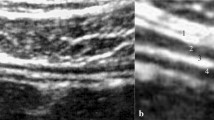Abstract
Bowel obstruction (BO) in children has a wide differential diagnosis, ranging from non-urgent conditions to surgical emergencies. Abdominal radiographs are most often used as the first imaging modality for the evaluation of obstruction. However, for some indications, ultrasound can be the primary imaging modality. Therefore, it is incumbent on radiologists to recognize the types of bowel obstruction that can be recognized with US. Key sonographic features of BO include differential dilation of bowel loops, bowel wall thickening, and free fluid. “Do Not Miss” findings that indicate need for emergent treatment include volvulus, pneumoperitoneum, and/or signs of ischemia (bowel wall thinning and/or absent perfusion). The aim of this pictorial essay is to provide guidance on the sonographic technique and findings that enable identification of BO on US. Examples of neonatal BO on US, including common and less frequently encountered etiologies, are illustrated in this pictorial essay.









Similar content being viewed by others
Data availability
Data is available at request.
References
Dunn EA, Olsen ØE, Huisman T (2018) IDKD Springer Series the pediatric gastrointestinal tract: what every radiologist needs to know. In: Hodler J, Kubik-Huch RA, von Schulthess GK (eds) Diseases of the abdomen and pelvis 2018–2021: diagnostic imaging - IDKD book. Springer, Cham, pp 157–166
Gale HI et al (2016) Abdominal ultrasonography of the pediatric gastrointestinal tract. World J Radiol 8(7):656–667
Vinocur DN, Lee EY, Eisenberg RL (2012) Neonatal intestinal obstruction. AJR Am J Roentgenol 198(1):W1-10
Gokli A et al (2020) Contrast-enhanced US in Pediatric Patients: Overview of Bowel Applications. Radiographics 40(6):1743–1762
Kuzmich S et al (2013) Sonography of small bowel perforation. AJR Am J Roentgenol 201(2):W283–W291
van Wassenaer EA et al (2020) Bowel ultrasound measurements in healthy children - systematic review and meta-analysis. Pediatr Radiol 50(4):501–508
Chiorean L et al (2014) Transabdominal ultrasound for standardized measurement of bowel wall thickness in normal children and those with Crohn’s disease. Med Ultrason 16(4):319–324
Verma A, Rattan KN, Yadav R (2016) Neonatal intestinal obstruction: a 15 year experience in a tertiary care hospital. J Clin Diagn Res 10(2):Sc10–Sc13
Ngo AV, Stanescu AL, Phillips GS (2018) Neonatal bowel disorders: practical imaging algorithm for trainees and general radiologists. AJR Am J Roentgenol 210(5):976–988
Alazraki AL et al (2020) ACR appropriateness criteria® vomiting in infants. J Am Coll Radiol 17(11s):S505-s515
Baad M et al (2020) Diagnostic performance and role of the contrast enema for low intestinal obstruction in neonates. Pediatr Surg Int 36(9):1093–1101
Nguyen HN et al (2022) Ultrasound for midgut malrotation and midgut volvulus: AJR expert panel narrative review. AJR Am J Roentgenol 218(6):931–939
Nguyen HN et al (2021) Transition to ultrasound as the first-line imaging modality for midgut volvulus: keys to a successful roll-out. Pediatr Radiol 51(4):506–515
Choudhry MS et al (2009) Duodenal atresia: associated anomalies, prenatal diagnosis and outcome. Pediatr Surg Int 25(8):727–730
Hameed S et al (2020) The role of sonography in differentiating congenital intrinsic duodenal anomalies from midgut malrotation: emphasizing the new signs of duodenal and gastric wall thickening and hyperechogenicity. Pediatr Radiol 50(5):673–683
Borghei P et al (2013) Anomalies, anatomic variants, and sources of diagnostic pitfalls in pancreatic imaging. Radiology 266(1):28–36
Yang B et al (2019) Diagnostic value of the acute angle between the prestenotic and poststenotic duodenum in neonatal annular pancreas. Eur Radiol 29(6):2902–2909
Zhang W, Sun H, Luo F (2017) The efficiency of sonography in diagnosing volvulus in neonates with suspected intestinal malrotation. Medicine (Baltimore) 96(42):e8287
Esposito F et al (2019) The pediatric gastrointestinal tract: ultrasound findings in acute diseases. J Ultrasound 22(4):409–422
Nguyen HN et al (2021) Untwisting the complexity of midgut malrotation and volvulus ultrasound. Pediatr Radiol 51(4):658–668
Taylor GA (2011) CT appearance of the duodenum and mesenteric vessels in children with normal and abnormal bowel rotation. Pediatr Radiol 41(11):1378–1383
Aboagye J et al (2014) Age at presentation of common pediatric surgical conditions: Reexamining dogma. J Pediatr Surg 49(6):995–999
Epelman M (2006) The whirlpool sign. Radiology 240(3):910–911
Choi G, Je BK, Kim YJ (2022) Gastrointestinal emergency in neonates and infants: a pictorial essay. Korean J Radiol 23(1):124–138
Das K, Mohanty S (2017) Hirschsprung disease - current diagnosis and management. Indian J Pediatr 84(8):618–623
de Lorijn F et al (2005) Diagnosis of Hirschsprung’s disease: a prospective, comparative accuracy study of common tests. J Pediatr 146(6):787–792
Inarejos Clemente EJ et al (2021) Omphalomesenteric duct anomalies in children: a multimodality overview. Radiographics 41(7):2090–2110
Kotecha M et al (2012) Multimodality imaging manifestations of the Meckel diverticulum in children. Pediatr Radiol 42(1):95–103
Sangüesa Nebot C et al (2018) Enteric duplication cysts in children: varied presentations, varied imaging findings. Insights Imaging 9(6):1097–1106
Di Serafino M, Mercogliano C, Vallone G (2016) Ultrasound evaluation of the enteric duplication cyst: the gut signature. J Ultrasound 19(2):131–133
di Giacomo V et al (2015) Ultrasound in newborns and children suffering from non-traumatic acute abdominal pain: imaging with clinical and surgical correlation. J Ultrasound 18(4):385–393
Wang KS (2012) Assessment and management of inguinal hernia in infants. Pediatrics 130(4):768–773
Chandrakala R, Vijayashankara CN (2005) Neonatal inguinal hernia. Indian Pediatr 42(10):1048
Gök MA, Büyüközsoy AK, Kafadar MT (2022) The sensitivity of ultrasound in the clinical diagnosis of inguinal hernias in adults: a comparative study. J Ultrasound 25(3):655–658
Funding
Nothing to disclose.
Author information
Authors and Affiliations
Contributions
All authors contributed to the paper conception and design. LM, DMS, RS: performed material preparation. The first draft of the manuscript was written by RS and all authors commented on subsequent versions of the manuscript. All authors read and approved the final manuscript.
Corresponding author
Ethics declarations
Conflict of interest
The authors declare that they have no conflict of interest.
Ethical approval
Not applicable.
Consent to participate
Not applicable.
Consent to publish
Not applicable.
Additional information
Publisher's Note
Springer Nature remains neutral with regard to jurisdictional claims in published maps and institutional affiliations.
Supplementary Information
Below is the link to the electronic supplementary material.
Supplementary file3 Online Resource 3: Twelve day-old girl with malrotation and midgut volvulus. Transverse grayscale and color Doppler ultrasound images of the abdomen show abnormal alignment of the SMA and SMV with clockwise whirlpool sign. The third portion of the duodenum was not identified in its normal retroperitoneal course between the aorta and SMA. (MP4 8080 KB)
Rights and permissions
Springer Nature or its licensor (e.g. a society or other partner) holds exclusive rights to this article under a publishing agreement with the author(s) or other rightsholder(s); author self-archiving of the accepted manuscript version of this article is solely governed by the terms of such publishing agreement and applicable law.
About this article
Cite this article
Salman, R., Mertiri, L., Seghers, V.J. et al. Ultrasound imaging of bowel obstruction in neonates. J Ultrasound (2024). https://doi.org/10.1007/s40477-023-00858-5
Received:
Accepted:
Published:
DOI: https://doi.org/10.1007/s40477-023-00858-5




